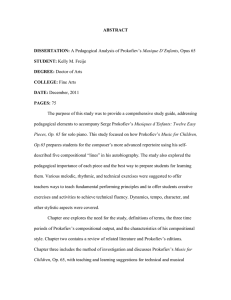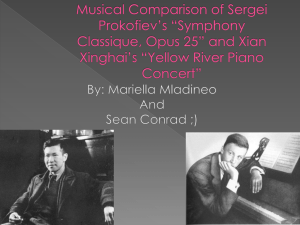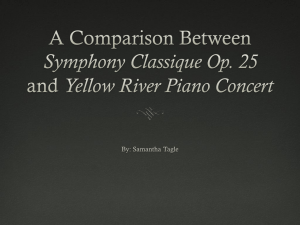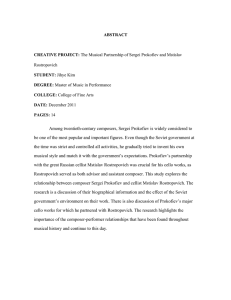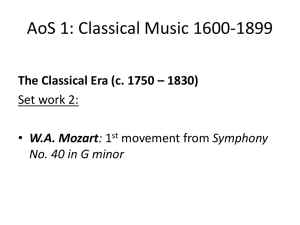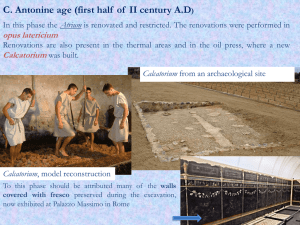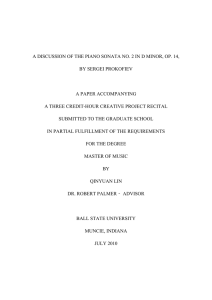A Comparison on Rhythm - The Spirit of Great Oak
advertisement
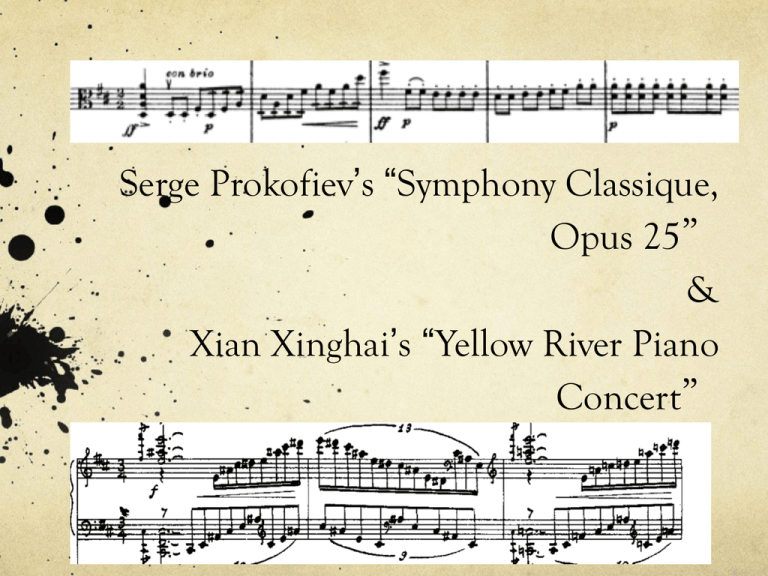
Serge Prokofiev’s “Symphony Classique, Opus 25” & Xian Xinghai’s “Yellow River Piano Concert” Serge Prokofieff Russian composer, pianist, and conductor Born in 1891 in Sonstavoska and died in 1953 Some of his best known works are the suite Lieutenant Kije the ballet Romeo and Juliet Lived during the Russian Revolution, left the country in 1918 residing in Paris, the United States and Germany In 1936 he moved back to Russia and was forced due to finances to compose for Stalin Characteristics His compositions were innovative Known for strange new harmonies, dynamic rhythms and lots of humor He had a full portfolio of compositions by age of 13 when he entered the St. Petersburg Conservatory St. Petersburg Conservatory Developed a reputation for being a rebellious composer He considered school to be boring Labeled as arrogant Graduated with poor grades Shows his natural talent for composition Symphony No. 1, Opus 25 Prokofiev’s compositions were often imitations of his favorite composers Symphony No. 1 in D Major Opus 25 was an imitation of the styles of Haydn and Mozart One of the first neoclassical compositions, reflects modern compositional practices Four movements: allegro, larghetto, gavotta, and finale 2 flutes, 2 oboes, 2 clarinets, 2 bassoons, 2 horns, 2 trumpets, timpani and strings Xian Xinghai Native of Guangdong Province (1905-1945) Raised by impoverishd single mother, no steady home First Chinese student to enroll in Paris Music Academy in 1934 Composed Yellow River Cantata in six days in a cave Yellow River Cantata Great historical significance, very nationalistic Song of inspiration for Chinese people during horrific genocide The song has become a Chinese symbol of heroism and solidarity Yellow River Piano Sonata Adapted from Yellow River Cantata by a group of musicians from the Central Philharmonic Society in 1969 Composed during anti-Japanese war and Cultural Revlution, bears great historical significance Chinese folk instruments Pentatonic scales His Composition European influence: use of piano to capture tones and moods Western choral textures The Yellow River Cantata was transformed into a composition for an entire Western Orchestra Utilization of Western instruments Rhythm: Prokofiev Begins allegro 100 bpm 2/2 Pattern of quarter note followed by six eighth notes Variety of notations: stacatto, tenuto, slur, accents, leggiero, caesura Each section has a different tempo Rhythm: Xian Xinghai Begins vivace, 152 bpm Shifts between ¾ and 2/4 throughout Sixteenth notes and eighth notes Accents, ties in bass, slurs, grace notes, fermatas, triplets Each movement has a different tempo from 54 to 160 Similarities Little to no syncopation, notes land on accented syllables Fast and slow sections The tempo changes dramatically with each section Note values are similar throughout Differences: Xinghai Frequent shifts in time signature Frequent shifts in tempo Long runs of notes with equal value (8th or 16th) with chromaticism Quick runs extend for longer periods Prokofiev • Constant time signature throughout • Four Movements: Allegro, Larghetto, Gavotta, Finale • Quick runs are grouped in flurries Works Cited http://en.wikipedia.org/wiki/Sergei_Prokofiev http://upetd.up.ac.za/thesis/available/etd-07082008094928/unrestricted/dissertation.pdf http://en.wikipedia.org/wiki/Xian_Xinghai
